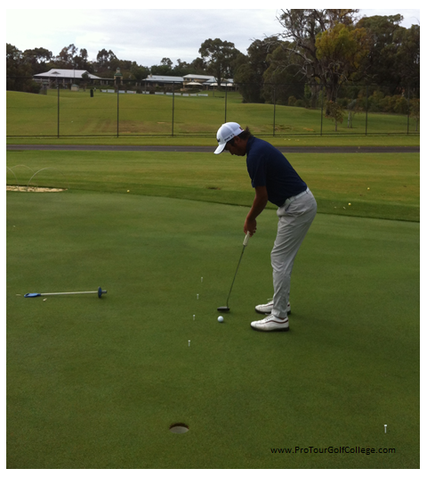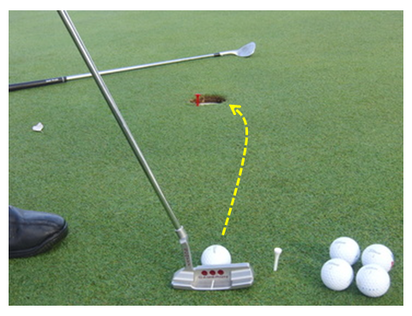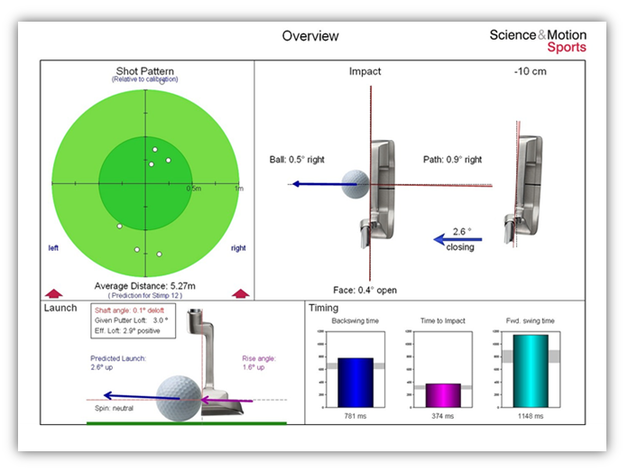 Tiger Practicing His Right Hand Only Between 2 Tees Drill All tour pro's have drills that they use to help keep their putting in good shape as it is critically important and you can learn how to do the same. You will never learn how to break par if you don't learn how to become an outstanding putter like the top pro's on tour. First you have to decide are they to improve technique or drills to simulate tournament intensity and improve performance? Of course they both go hand in hand to help you improve your putting but just like the full swing you have to decide whether you are focused on improving putting technique or focused on improving putting performance. When you try to do both at the same time it is a recipe for certain failure and frustration. The rule of "You can obey only one master at one time" must be observed and followed. Tiger Woods likes to use two tees as a gate to putt through (see above) with just his right hand for tempo and distance control. He likes to focus on achieving solid contact with every putt he hits. Lets start with drills where training aids are used to improve technique. There are alignment tools for better aim at address, gadgets that guide the path of the putting stroke, aids that help with maintaining the optimum tempo for all putts. Most pro's will only use a training aid for drill work once they have identified which area of their technique is the cause of the problem. They will get assessed on a motion analyzer like Sam Putt Lab or the Tomi Putting System which will identify that area and together with their coach select the training aid that will drill the new adjustment in.  The Alignment Putting Mirror Drill The most popular training aid on tour is probably the mirror which can check if the putter face is square at address. It also lets the pro check if his eyes are positioned in the optimal position in relation to the ball. Used with a "string-line" (pic below) it is the best self - check tool that the pro's use on tour A metronome is also a very helpful tool to drill the correct tempo required to achieve consistent distance control on all putts.  The String-Line Drill As mentioned the string-line drill is one of the best and should be used every week to control the direction of your ball from the putter face. Once you have improved the area in your technique that has been holding you back then you are ready to progress to the drills that will improve performance. There are many drills that the pro's on tour use but its the putting drill's that simulate a similar intensity to that which they experience in competition that are the most useful. These drills must always be performed with your full pre- shot routine for them to be really effective and also transferable into your competition rounds.  The Compass Drill The compass drill begins by placing tees at 3 feet, 6 feet, 9 feet and 12 feet from the hole and from four directions (N,S,E,W). Ideally set-up this drill by giving yourself an uphill. downhill, left to right and right to left putt. This will give you 16 different putts that have to be completed in sequence (1a, 1b, 1c, 1d, 2a...) otherwise the drill has to be repeated from tee 1a again which increases the pressure for each putt until completed. A time limit of 30 minutes maximum is suggested and the best sequence of putts in a row is recorded. Another compass drill is putting ten balls from each of the sixteen tee's (total 160) and record how many are converted and the good putters will average 70% or 112 out of the 160 attempts. At Pro Tour Golf College our students aim for what we call "The 70 Percent Putter" which is a score of 100% for 3 feet, 80% for 6 feet, 60% for 10 feet and 40% for 14 feet. No one in our tour bridging program has so far has achieved 70 percent status, but they're getting close to it.  The Gate Drill Another popular drill is the gate drill which helps with the start line of the putt. You can use this drill for short and long putts with great effectiveness. Place a ball approximately one meter in-front of where you intend to putt from and position two tees either side of the front ball. (We're using a putting hoop in the photo in case you were wondering) Remove the front ball and putt from the chosen spot and see how many balls you can stroke through the 'Gate' in sequence. The time limit 15 minutes and you will be amazed how much better you will putt once you are able to start the ball on the line you pick, and this will translate into more of your putts made in competition.  The Breaking Putt Drill The breaking putt drill encourages the ball to enter the hole on the "high side" will train you to match the speed and line. As the picture shows place a tee that blocks a quarter of the hole on the low side and start from 3 feet with five balls. Two points are awarded for sinking a putt, one point if the ball lips out and stays inside the 18 inch zone - which is inside the club behind the hole. You get zero points if your ball misses high side and stays inside the 18 inch zone. Score a - 2 for hitting tee and - 3 for missing on the low side. This drill will get your attention and improve your stats for breaking putts. Move out to 6 feet then 9 feet and finally 12 feet and change sides to train both types of breaking putts. Always record your scores to keep an average for the drill and also remember to maintain your intensity level. A good average for the 20 putts is 28 out of a possible score of 40 which translates again to 70%. Work toward achieving a score of 10 from 3 feet (make all 5 putts), score 8 from 6 feet (make 4 putts, and finish inside the 18" zone with the other ball ), score 6 from 9 feet (make 3 putts and finish inside the 18" zone with the other two, score 4 from 12 feet (make 2 putts and finish inside the 18" zone with the other three.  Before the start of your round place a single tee in the putting green and putt to the tee starting from 3 feet. When you hit the tee move out to 4 feet and repeat until you get to 12 feet. By doing this you will not have missed the hole with a putt and you have narrowed your focus which will help once you get out on the course. Try this drill the next time before you go out and I'm sure you will not be disappointed. Practicing your putting from the fringe is always useful to get a sense of the speed required, and I see most tour pro's doing this so they are more prepared when they choose to putt from just off the green. Which ever putting drill you decide to include in your training routines always decide whether you will be working on your putting technique or improving your putting performance. Never both! For drills to be effective they have to have a purpose and be designed for improvement. So if you have a putting drill that you use and have found it useful please let me know and I will put them up on the website for other golfers like you who are interested in improving their putting. Enjoy testing and having fun with these drills. David Milne and Lawrie Montague - Pro Tour Golf College Your Success On Tour is Our Business |
Archives
June 2019
|
Proudly Supported By
Copyright © 2011 - 2018 Pro Tour Golf College
Website Managed By Golf Performance Media
All Rights Reserved
Website Managed By Golf Performance Media
All Rights Reserved


 RSS Feed
RSS Feed



